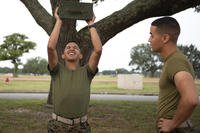After you first spend 4-6 weeks building up your running ability with the 400-meter set that increases speed with each workout, it is time to take your training to the next level by running 800 meters. This distance is one of the most hated in the competitive runner's world, and that sentiment flows down to anyone preparing for military fitness tests.
Mastering the 800 meters at your goal pace or faster can be the difference between just passing or maxing the timed run for your military fitness test. Check out this workout combination of warm-ups, distances, times and rest periods to take your timed run efforts to new heights.
Squat Pyramid 1-10 with 100-Meter Run Warm-Up
This classic warm-up is a great way to get ready for the running and repetitions of leg exercises. Here is how this section looks:
- 1 squat, jog 100 meters (don't sprint) and mix in a few dynamic stretches for 10-20 meters each set.
- 2 squats, jog 100 meters and continue dynamic stretches.
- 3 squats, jog 100 meters. Keep going until you get to set 10.
This totals 55 squats, 1,000 meters of jogging and dynamic stretches. If you feel warm after 5-6 sets, it is fine to move on to the rest of the workout, especially if you feel 55 squats is going to affect your run times during the next set.
What you do for the meat of this workout depends on your current running abilities. You can start with only four sets and build up to eight sets over time.
The workout below sits in the middle of that spectrum and requires six 800-meter runs. If you are not up to running three miles in a single workout, drop down to 3-4 sets and logically progress up to the next levels through additional repetitions.
6x 800-Meter Intervals
The goal of this workout is to start at an eight-minute mile pace and then run each 800-meter set 20 seconds faster than that previous set. You can opt to start at a nine-minute mile pace if you find a sub-eight-minute mile pace too difficult.
- Run 800 meters: 4 minutes
- Run 800 meters: 3:40
- Run 800 meters: 3:20
- Run 800 meters: 3:00
- Run 800 meters: 2:40
- Run 800 meters: 2:20 or as fast as you can.
When you fail to keep up with the increases in speed, stop trying to increase and drop back to your goal mile pace for the remaining sets. For instance, if you are trying to run a six-minute mile pace for timed runs, but fail to hit the 2:40 time, make your final set a notch slower to your goal pace of a six-minute mile or three-minute half-mile.
Rest Each Set
If you find the first few sets easy, only walk 100 meters. As you start to push your speed, you may prefer a 200-meter walk between sets before starting the next faster set.
If you have anything left in the tank, try to spend the remaining sets doing shorter, faster runs of 200 meters. There is no set time, but there is no need to sprint at 100%. Make this faster than your goal pace and push to get 30-40 seconds. Add squats and lunges to each set as your "rest."
Repeat five times.
- Run: 200 meters fast
- Squats: 20
- Lunges: 10 per leg
Optional Grand Finale
Depending on your planned future training and your abilities, consider topping off the running leg day with a ruck or a swim with fins. If you are preparing for swimming tests or future diving training, mix in some swimming.
If you are going to be more land-based and load-bearing, put on a backpack and ruck for 30-40 minutes. This can be done in a separate workout after you have recovered from the above workout.
- Swim: 500-meter warmup
- Swim: 2,000 meters with fins for time
Or
- Ruck for 30-40 minutes with 30-40 pounds
You can scale this workout (squat warmup and 800-meter runs) to fit your abilities and see improvements in a matter of a few weeks. How you structure this workout to scale back or ramp up the miles and speed will depend on your current abilities and military fitness goals. Enjoy the workouts and the journey as you prepare for a future of challenging military training.
Stew Smith is a former Navy SEAL and fitness author certified as a Strength and Conditioning Specialist (CSCS) with the National Strength and Conditioning Association. Visit his Fitness eBook store if you're looking to start a workout program to create a healthy lifestyle. Send your fitness questions to stew@stewsmith.com.
Want to Learn More About Military Life?
Whether you're thinking of joining the military, looking for fitness and basic training tips, or keeping up with military life and benefits, Military.com has you covered. Subscribe to Military.com to have military news, updates and resources delivered directly to your inbox.


















